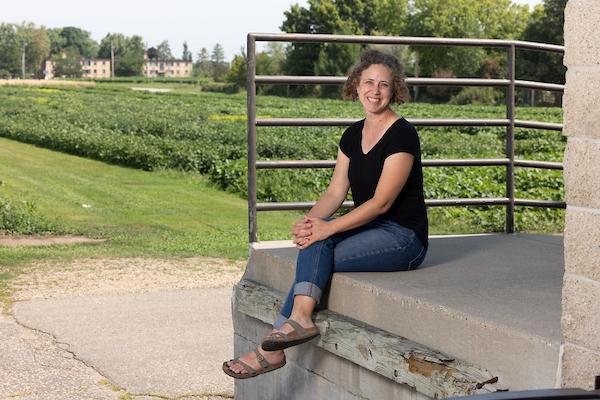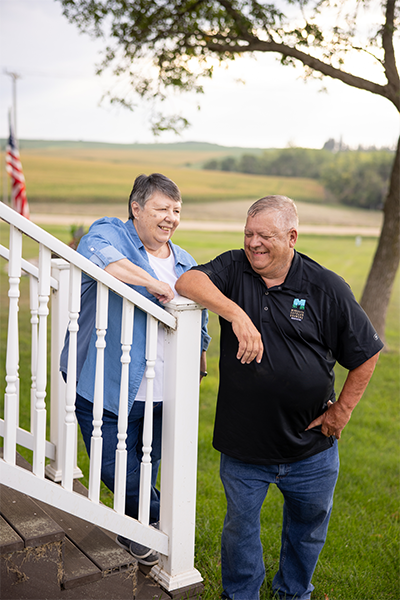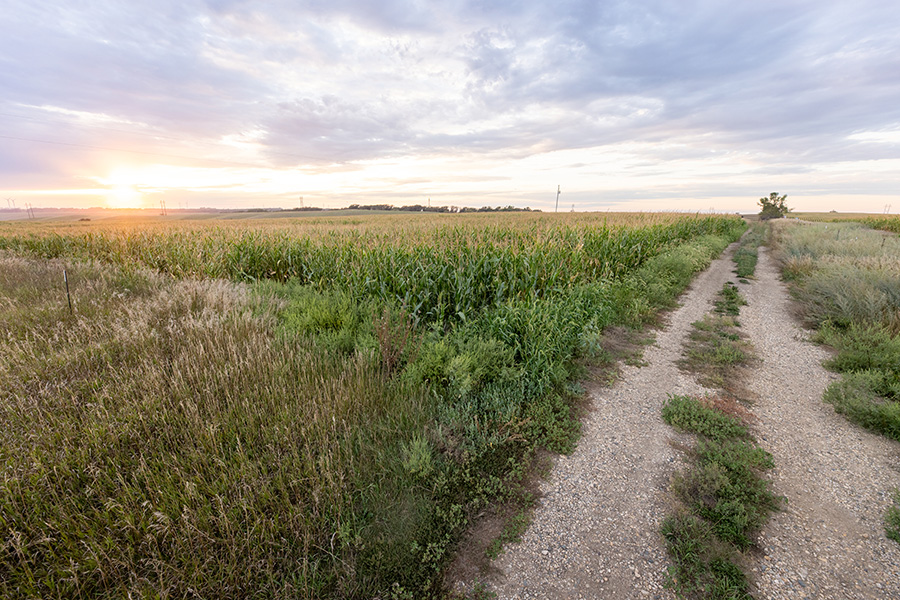Finding healthcare and support has never been more challenging in rural areas. Researchers are studying how to support rural people at every stage of life.

There’s a notion that the country is a healthier place than the city, that breathing fresh air, and living and working among green growing things makes rural people more hale and hearty, and psychologically balanced, than their city cousins.
There’s truth to the story, of course; yet contemporary rural America has serious health challenges that can be hard to spot amid the hills, fields, and peaceful-looking small towns. The School of Public Health (SPH) is addressing these challenges through research and outreach — studying often hard-to-see health problems in-depth and collaborating with local communities to generate solutions.
Carrie Henning-Smith, associate professor and deputy director of SPH’s Rural Health Research Center (RHRC), says that rural health issues add up to “a very long list, and they’re interrelated, which is what makes the situation so complex.”
She underlines some of the main areas of concern that affect residents from birth through old age:
- Closure of hospitals and maternal care units
- Lack of mental health support
- Difficult transportation to and from healthcare sites, including miles of unpaved roads that can become impassable, and very little public transit
- Lack of affordable, reliable broadband limiting telehealth options
- An aging population with few healthcare providers
- High rates of unemployment and poverty
- Lack of adequate housing and access to healthy foods
SPH studies all of these issues as it strives to meet the needs of rural Minnesota and beyond. Below, we explore three of the school’s rural health research areas: maternal health access, mental health support, and healthy aging.
Having a Baby in Rural America
According to a 2022 report from the March of Dimes, more than 2.2 million U.S. women of childbearing age live in “maternity care deserts” — places with no hospitals that provide obstetric care, no birth centers, and no obstetric providers.
In an April 2023 CNN interview, SPH Professor and RHRC director Katy Backes Kozhimannil said that the communities most likely to be hit by the closure of maternity units are remote towns in rural counties.
Closures mean that expectant mothers need to travel farther for care, and “that long drive isn’t just an inconvenience, it actually is associated with health risks,” said Kozhimannil. “The consequence is an increase in preterm births. Preterm birth is the largest risk factor for infant mortality. It is a huge risk factor for developmental and cognitive delays for kids.”
Along with her extensive research on rural health problems, Kozhimannil has also contributed to legislation addressing the lack of rural, maternal care. Her work influenced the national Rural Maternal and Obstetric Modernization of Services (Rural MOMS) Act passed in 2022.
The measure provides funding for the Health Resources and Services Administration (HRSA) to set up rural networks that connect people with obstetric care providers and rural providers with each other; identify successful maternal-care models; support training, academic research, and telehealth; and measure and address inequities in birth outcomes among rural residents.
But when it comes to providing care, rural hospitals are caught between a rock and a hard place, explains Assistant Professor Caitlin Carroll, who studies the consequences of hospital closures.
“Obstetric units are often unprofitable for hospitals,” she says. “The fixed cost of an obstetric unit is really substantial. They have to be ready 24 hours a day to take care of someone giving birth. They need clinical staff with specialized skills, they need specialized equipment, they need dedicated space for labor and delivery — and all of that costs money.
Asked if health systems acquiring rural hospitals would help, Carroll says that depends on motivation.
“On one hand, national systems have more resources, so they could make a capital investment in the rural hospital and help it stay open,” she says. “On the other hand, they might be tempted to downsize it, to cut out unprofitable services like obstetric care.”
Meeting Mental Health Needs
SPH researchers are finding ways to support two groups in rural areas that often have significant mental health stressors: LGBTQ+ rural residents and farmers.
Supporting Young People
Recognizing that the needs of rural LGBTQ+ people are undersupported, in 2021, RHRC embarked on a large-scale study of rural/ urban inequities in LGBTQ+ health and healthcare access. In the process, they found a particularly underserved group: queer, rural youth. “We saw a need to highlight programs focused specifically on youth,” says RHRC researcher Maddy Pick, MPH ’19. “We wanted to see how they were supporting queer youth and how they were perceived in their communities. Our hope is to inspire others looking to advance their work in this area.”
“We know that social connection and a sense of belonging are really important for mental health. And for physical health as well, in terms of keeping LGBTQ+ folks safe from acts of violence.”
Maddy Pick, MPH ’19
Pick created what became a case study, “Rural and Community-Based Programs Supporting LGBTQ+ Youth.” After a nationwide outreach effort, she and her colleagues connected with four programs: high school LGBTQ+ support organizations in rural Maine and Minnesota; Southwest Minnesota State University’s LGBTQ+ Center; and East Central Minnesota Parents, Family, and Friends of Lesbians and Gays.
Leaders in these organizations emphasized their value as places to gather and sources of reliable information about LGBTQ+ issues for students, teachers, and the community.
“We know that social connection and a sense of belonging are really important for mental health,” says Pick. “And for physical health as well, in terms of keeping LGBTQ+ folks safe from acts of violence. Belonging also bolsters school attendance and academic standing. Educational success is a key determinant of health, so support, or its absence, can have really long-term impacts.”
It’s Not All Bucolic

Farming is physically dangerous, with a work-related death rate higher than that of police officers, firefighters, and other emergency responders. And suicide is a serious problem: Estimates point to farmers taking their lives at a rate three to five times higher than other workers. After years of neglect, farming’s toll on mental health is slowly gaining recognition.
The Upper Midwest Agricultural Safety and Health Center (UMASH), headquartered at SPH, researches a broad spectrum of ag-related health issues, works with local leaders to learn about their concerns, provides training and resources on farm safety, and presents at gatherings, such as Minnesota’s annual FarmFest.
Beginning around 2015, UMASH staffers at FarmFest and elsewhere were hearing more and more stories of anxiety, depression, and suicidal thinking from farmers. The result was a UMASH/Minnesota Department of Agriculture partnership that hosted a forum called “Building Resilient Agricultural Communities.” The forum focused on stress and mental health challenges for farmers, agricultural workers, and their families and it resulted in new programs and initiatives to support farmers’ mental health.
In the wake of the forum, UMASH funded three mental-health-related projects tailored to ag-specific anxieties and other issues unique to farming. For one project, they worked with the Minnesota chapter of the National Alliance for Mental Illness to develop a suicide-prevention training program designed, says Megan Schossow, outreach director and center coordinator for UMASH, “to equip people with compassionate language and tangible ideas of how to intervene if you suspect someone may be thinking about suicide or struggling.”
“There is still a tremendous amount of stress and depression on the farm today. It’s a sign of the times and I think it’s just the way it’s going to be until we get a good handle on it.”
Bob Worth
Bob Worth is a soybean farmer with an operation near Lake Benton in southwestern Minnesota that he has run since 1970. He’s also held multiple offices in the Minnesota Soybean Growers Association, including the presidency since 2022. His story is evidence of how much it matters that people know how to support someone when they’re in trouble.
“I didn’t want to get out of bed”

The farm crisis of the 1980s was a triple-whammy of declining agricultural prices, burdensome debt at interest rates as high as 21%, and falling land and equipment values. It hit Worth hard.
“When you went to the bank, they leant money on your net worth,” he says. “But the value of all your assets was dropping, while your debt wasn’t. So you had no borrowing power. You couldn’t do anything.”
The situation sent Worth into a downward spiral. “I didn’t want to get out of bed,” he says. “It was harvest time and I didn’t even want to go and harvest. I just wanted to stay in the house and not do anything.” Luckily for him, his wife, Gail, noticed the changes in her husband and intervened. “I’m kind of a joyful guy and she noticed that I had become a gloomy person who didn’t want to engage with other people,” Worth says. “I was very depressed, as I know now. Gail’s the one who persuaded me to see a doctor.”
A young physician’s assistant saw Worth. “I thank him many times, because he got me through this,” Worth says.
Asked how he takes care of himself today, he says, “I talk about it! I talk about stress and depression, because you know what? Things haven’t changed a lot. There is still a tremendous amount of stress and depression on the farm today. It’s a sign of the times and I think it’s just the way it’s going to be until we get a good handle on it.”
Worth speaks out on the issue whenever he can. In an op-ed on the website Illinois Farmer Today, he writes, “Farmers are very private people and don’t like to talk about their own personal problems, but we need to start talking. You’re not the Lone Ranger: There are more people struggling with this than you’ll ever realize. As a farmer who has experienced the impact of farm stress firsthand, I can’t stress enough — don’t be ashamed. It’s part of life — don’t keep it to yourself.”
Growing Old in Rural America
The American population is aging, and that trend is particularly significant in rural places. A higher percentage of people over 65 live in rural areas rather than cities (17.5 % versus 13.8%). And although only 15% of the total U.S. population resides in rural areas, nearly 25% of all older Americans live in the country.
SPH’s Center for Healthy Aging and Innovation (CHAI), dedicated to finding new ways of helping Americans of all ethnicities age with joy and dignity, is focused on supporting the rural older adult population. Henning-Smith, an active member of CHAI and who sits on their research committee, has extensively studied social well-being and isolation among older rural and urban Americans. She finds that the social infrastructure that rural people depend on is a critical component of their mental and physical health. In her work, she discovered both strong resources and gaps in that infrastructure.
Enter a remarkable resource named Ann Bussey. The retired hospital executive, who lives on the Iron Range in northern Minnesota, is a consumer representative on the Minnesota Department of Health’s Rural Health Advisory Committee (RHAC), which advises state agencies on the health needs of rural residents, supports planning, and fosters cooperation among communities and healthcare providers.
A group of senior women on the Iron Range were running a highly popular exercise class that provided social connections along with physical benefits, but the group lost their venue twice. They appealed to Bussey, and after some string-pulling, she found the class a new home in a YWCA.
Bussey worked hard because she understands the value of these resources for older people in small places. Although SPH research has shown that rural residents report larger and stronger social networks than their urban counterparts, it’s critical to maintain spaces for them to come together.
“If you live in any of Minnesota’s metro areas, there are gyms, there are programs, there’s stuff during the day,” Bussey says. “That’s not always the case in rural communities. People tell me, ‘I want to go somewhere besides the grocery store to run into somebody I know.’ ”
When the pandemic hit, Bussey became a one-woman internet resource for older people in and around the Iron Range town of Hibbing, posting all kinds of healthy aging information to a database of over-65 citizens she obtained from the Y. In the process, she discovered that 30 to 40% of the people in the database had digital deficits — no broadband, no email, or some other lack of digital connectivity. Rural older adults were struggling to connect both online and in-person.
In 2023, Bussey was chosen as one of the inaugural fellows of UMN’s Project REACH (Rural Experts Advancing Community Health), run by Henning-Smith, Kozhimannil, and RHRC program manager Katie Rydberg. As a community partner, Bussey wrote a plan for increasing rural digital literacy and connectivity by turning the state’s 355 public libraries into “the IT department for retirees.” Her plan has become a key element in Minnesota’s official push to increase digital inclusion.
Bussey’s message about the needs of rural older adults is simple and powerful: “Elder policy is stuck in the 1960s, when life expectancy was around 70,” she says. “Today people often live into their 80s. Our aging services are about support and service, which are good. But that usually translates to long-term care and assisted living, and doesn’t capture who the elderly are anymore. We’re living longer, we’re in communities, and we want community opportunities for purpose, personal agency, social engagement, connectedness, activity, and belonging.”
Raising Awareness
Meeting the needs of rural America is no small task. There are significant health challenges at every stage in life: from a child’s birth in an obstetric-care desert, to finding community and support in a place with few gathering spots and fewer health professionals, to meeting the needs of aging people.
More than 15% of Minnesota’s population lives in or nearby small towns or in more remote rural locations. Having access to healthcare is critical for them, as is the opportunity to get healthy food, find mental health support, and maintain health while aging in place. By raising awareness of the challenges facing people in rural areas, while also working together with communities and legislators to find solutions to rural health problems, SPH is making life better for people throughout the state, and the country.



